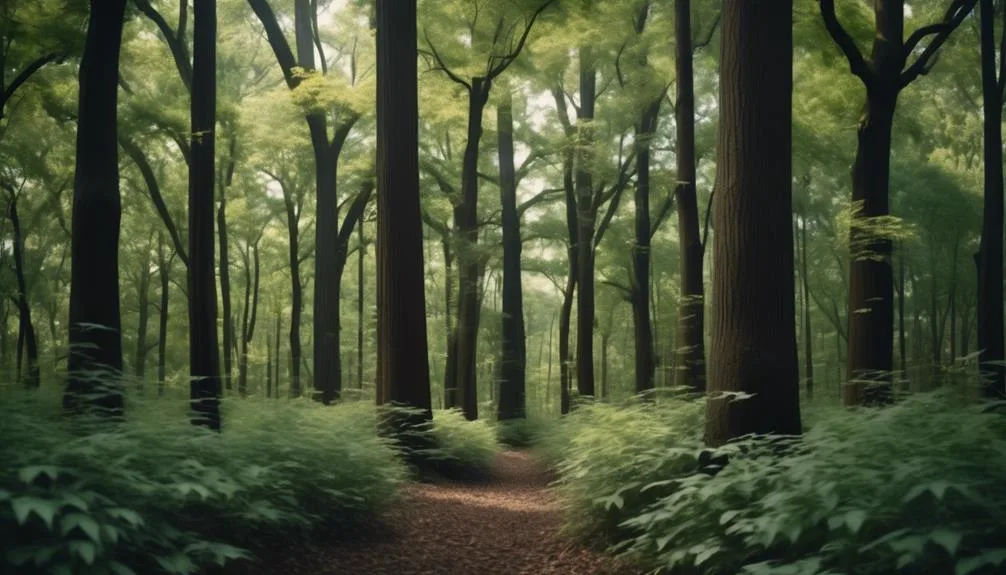Hickory trees are renowned for their strength and resilience, often described as 'tough as hickory.' These mighty trees naturally grow in the eastern United States and parts of Asia, spanning a wide geographic range.
Their preferred growing conditions, native habitats, and specific regions of thriving make for an intriguing study. Stay tuned to discover more about where hickory trees grow and what makes them thrive in their natural environment.
Geographic Distribution of Hickory Trees
Hickory trees thrive in a diverse range of habitats across North America, from the eastern United States to as far west as Texas and as far north as Canada. Their geographic range extends across various climates, including moist, well-drained soils in temperate regions.
Hickory trees tend to prefer areas with distinct seasons, where they can withstand cold winters and hot summers. They're commonly found in regions with deep, fertile soils and a good water supply.
Hickory trees have adapted to a wide range of climatic conditions, from the humid southeastern United States to the drier regions of the central and southwestern parts of the country. Their ability to grow in different climates makes them a prominent feature of the North American landscape.
Preferred Growing Conditions for Hickory Trees
Thriving in a diverse range of habitats across North America, hickory trees have specific growing conditions that contribute to their resilience and adaptability in various climates. Hickory trees prefer well-drained, deep, and fertile soils with a slightly acidic to neutral pH. They are particularly sensitive to waterlogged or compacted soils, which can hinder their growth. When it comes to climate preferences, hickory trees thrive in temperate regions with distinct seasons, although some species are also found in more subtropical climates. They generally prefer areas with abundant sunlight and consistent moisture, although they can also tolerate periods of drought. Below is a table summarizing the preferred growing conditions for hickory trees:
| Preferred Growing Conditions | Description |
|---|---|
| Soil Requirements | Well-drained, deep, fertile, slightly acidic to neutral pH |
| Climate Preferences | Temperate regions with distinct seasons, subtropical climates, abundant sunlight, and consistent moisture |
Native Habitats of Hickory Trees
Native to various regions in North America, hickory trees can be found in a range of habitats, from lowland forests to upland slopes. These native ecosystems provide ideal conditions for hickory trees to thrive and interact with wildlife.
Here's a quick look at the native habitats of hickory trees:
- Lowland Forests: Hickory trees are commonly found in the rich, moist soils of lowland forests, where they contribute to the diverse ecosystem and provide food and shelter for various wildlife.
- Upland Slopes: In upland slopes, hickory trees adapt to well-drained soils and more challenging growing conditions. These habitats showcase the tree's resilience and provide essential habitats for wildlife.
- Riverbanks and Floodplains: Hickory trees often thrive in the dynamic environments of riverbanks and floodplains, interacting with a wide array of wildlife species.
- Mixed Hardwood Forests: Within mixed hardwood forests, hickory trees coexist with other tree species, contributing to the complex web of wildlife interactions.
Range of Hickory Tree Species
Indigenous to various regions in North America, hickory trees exhibit a broad range of species that adapt to diverse habitats, contributing to the region's rich ecosystem. The different species of hickory trees, such as shagbark, shellbark, and pignut hickory, thrive in various climates and soil types.
This diversity not only provides a habitat for a wide array of wildlife but also plays a crucial role in the economic landscape. Wildlife interactions with hickory trees are abundant, as the trees provide food and shelter for various animals, including birds, squirrels, and deer.
Moreover, the economic importance of hickory trees is significant, as they're valued for their strong, shock-resistant wood used in furniture, tool handles, and flooring. The range of hickory tree species thus contributes to both the ecological balance and economic sustainability of North America.
Where to Find Hickory Trees in the Wild
Where can you spot hickory trees thriving in their natural habitat? If you're eager to encounter hickory trees in the wild, keep an eye out for these prime locations:
- Deciduous Forests: Hickory trees are commonly found in mixed hardwood forests, particularly in the eastern United States.
- River Valleys and Bottomlands: Look for hickory trees in low-lying areas near rivers and streams where the soil is rich and moist.
- Slopes and Ridges: Explore hilly or mountainous terrain, as hickory trees often flourish in well-drained, sloping landscapes.
- Wildlife Habitats: Hickory trees are vital for various wildlife interactions, so pay attention to areas where diverse animal species congregate.
When seeking out hickory trees in the wild, it's essential to familiarize yourself with their distinctive bark, leaves, and nuts for effective tree identification. Keep an eye out for these features while exploring their natural habitat.
Conclusion
To spot hickory trees in the wild, head to the eastern and central regions of North America, where well-drained soil and ample sunlight create ideal growing conditions.
Whether in forests, parks, or nature reserves, these majestic trees thrive in their native habitats.
Happy exploring!
Mark Hoffman is a dedicated arborist and tree care specialist with over a decade of experience. His love for trees began when he visited Yosemite National Park as a teenager and was awestruck by the giant sequoias. Mark pursued his passion by studying forestry at Michigan Technological University, where he earned a Bachelor of Science degree.
Since then, he has worked tirelessly in the field of arboriculture, helping to preserve and protect trees in his community. His expertise and dedication have made him a respected leader in the industry and a valuable resource for anyone seeking advice on tree care.
